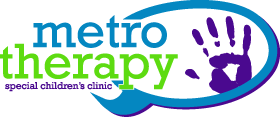Early Language Building Strategies for Parents
Your children imitate everything that you do, so you can and should be modeling good language skills for your kid. My name is Becca, I’m a speech-language pathologist at Metro Therapy in Fridley, Minnesota. Today I'm going to be talking about early language building strategies that parents can do at home to help promote language development in their kids.
1. Use the Self-Talk Strategy
One easy way to do this is to use the self-talk strategy. That is basically just narrating what you're doing while you're doing it.
For example, while you’re grocery shopping, you could be saying, “I need bananas. Where are the bananas? Let's go look at the fruit. Oh, I see the yellow bananas.”
2. Use the Parallel Talk Strategy
Another strategy is parallel talk, where you're narrating what the child is doing. For example, if the kid is playing with cars, you could say, “Oh, the car is going up the hill. You pushed it down the hill.”
3. Read Repetitive Books or Sing Repetitive Songs
Another really good strategy that we like to use is reading repetitive books or singing repetitive songs. For example, the book Brown Bear, Brown Bear, What Do You See? has a lot of repetitive language. And the song “Old MacDonald” is the same with a lot of repetitive phrases. This gives the child a lot of practice where, eventually, they might catch on and produce some of those words and phrases on their own.
4. Add Time to Countdowns
You can also use routine phrases paired with extra wait time. For example, if you say “ready, set, go!” to get your child to race off on some action, you can add a little extra time between “set” and “go” to see if the child will say “go” for you.
5. Provide Communication Temptations
Another really good strategy we like to use is providing communication temptations. That would mean withholding preferred toys or items that the kid would need to encourage them to communicate with you to ask for them. For example, if you set their toys out of reach, they then have to ask for help. Or if you move their toothbrush up high to a place that they can't reach, it's kind of forcing them to use their language to get help getting the toothbrush.
6. Use the “Plus One” Routine
Another really good strategy is called the plus one routine. This is basically just adding one word onto whatever the kid says. For example, if they point at the door and say, “Open,” you could say back to them, “Open door.” Over time, this will encourage them to use their words to mimic you and say, “Open door.”
7. Use the 3:1 Ratio
Another strategy we like to use is called the three to one ratio, which describes how many comments versus questions you should give when modeling language for children. For every one question that you ask, you should make three comments. It's really important not to bombard the kid with a bunch of questions because sometimes they feel like they can't really answer them.
For example, if you're talking about a teddy bear, you could say, “Where's the teddy bear?” That would be your one question. And then you make three comments. “He has brown fur, let's look under the table. I see it.”
8. Give Two Choices
Finally, our last strategy I'm going to talk about is giving two choices. This helps the kid feel like they have some power and control over what they do while still promoting their language development.
For example, if you're letting them pick out a toy, you could say, “Do you want Play-Doh or bubbles?” If it’s time to eat, you could say, “Do you want strawberries or bananas?” But it’s important to only use this strategy when you can actually give your child the choice. Meaning if it's nap time, don't say, “Do you want to take a nap?” Because more often than not, they'll say no, and then that leaves you in a hard position.
Call Metro Therapy for a Consultation
If you have any questions about these language strategies, or if you’d like to schedule a consultation to go over your child’s speech and language skills, feel free to give us a call at (763) 333-9547 and we'd be happy to help.
